Key takeaways
- Capture One excels in advanced color grading and seamless tethering, offering precise control for both beginners and professionals.
- The software’s customizable workspace enhances workflow efficiency, allowing users to tailor their editing environment to their needs.
- Users appreciate Capture One’s superior performance with RAW files and local adjustment tools, improving the editing experience significantly.
- Initial impressions reveal a modern, intuitive interface that fosters creativity and eases the transition for new users.
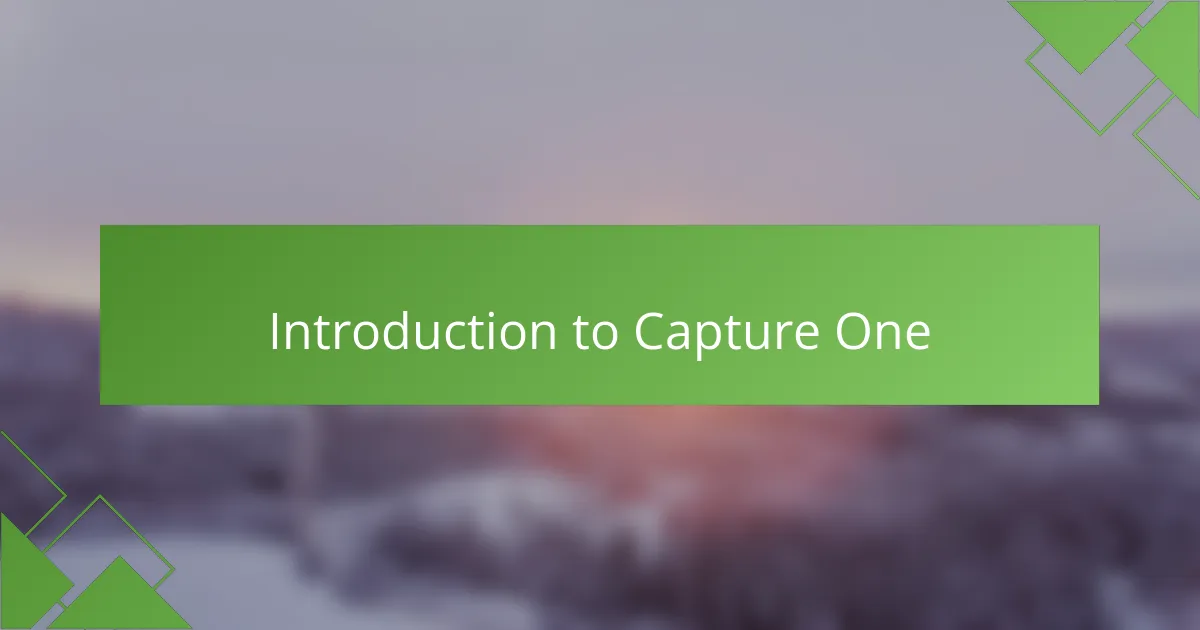
Introduction to Capture One
Capture One is a powerful image editing software that has significantly shaped my approach to photography. It offers precise color grading, versatile tethering options, and an intuitive interface that really resonates with my workflow. I remember the first time I used it for a project; the clarity and control over my images felt almost liberating.
What stands out for me is its ability to cater to both beginners and seasoned professionals alike. My journey with Capture One has been filled with moments of discovery, where I learned how to unlock the full potential of my photographs. The software’s robust features allow me to express my artistic vision more vividly, transforming ordinary shots into stunning visuals.
Here’s a brief comparison table summarizing Capture One’s features against some competitors:
| Feature | Capture One | Adobe Lightroom | Darktable |
|---|---|---|---|
| Color Grading | Advanced, layer-based | Basic | Intermediate |
| Tethering | Yes, highly optimized | Limited | No |
| Speed | Fast with large files | Good | Variable |
| User Interface | Customizable and modern | Classic and user-friendly | Less intuitive |
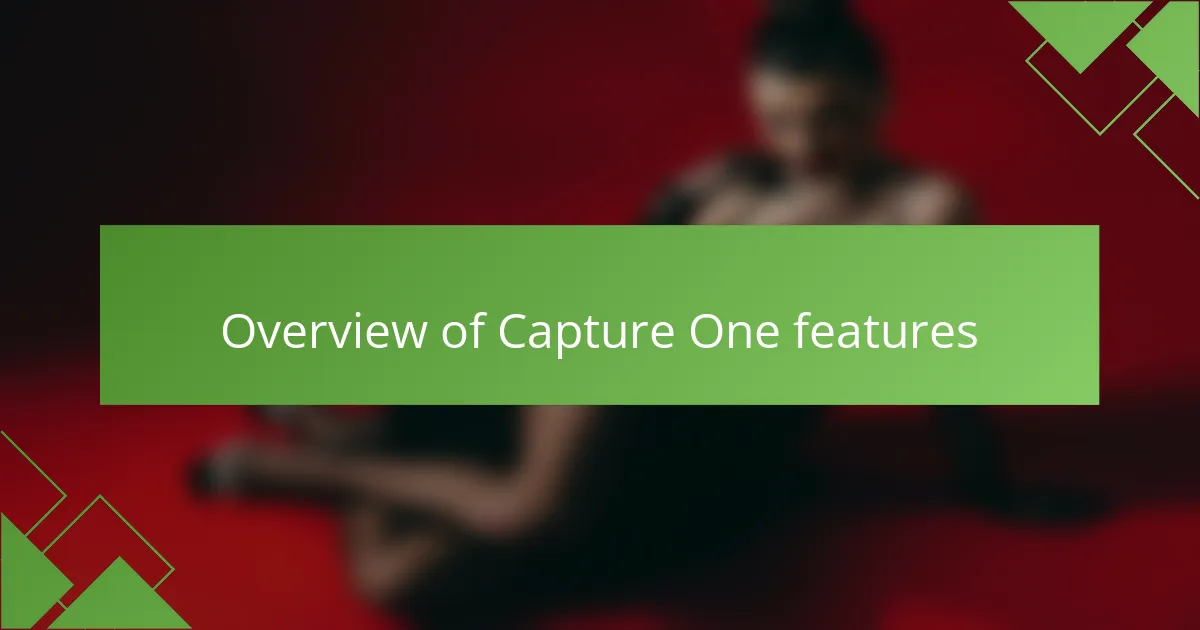
Overview of Capture One Features
Capture One is a powerful editing tool that offers a wide range of features tailored for photographers. One standout aspect is its color grading capabilities, which I find particularly intuitive. As someone who values color precision, I appreciate how easily I can achieve the exact mood I desire in my images.
Another feature that impresses me is the customizable workspace. I often tweak my layout depending on the project I’m working on, which keeps my workflow efficient and enjoyable. Additionally, the tethering capabilities are seamless, allowing me to shoot directly to the software, a game changer for studio photography sessions.
Here’s a comparison table highlighting some key features of Capture One and its alternatives:
| Feature | Capture One | Lightroom | Darktable |
|---|---|---|---|
| Color Grading | Advanced RGB and Luminosity controls | Basic color sliders | Limited color management |
| Customizable Interface | Highly customizable | Moderately customizable | Some customization options |
| Tethering Support | Seamless tethering | Good tethering, but less stable | Limited tethering options |
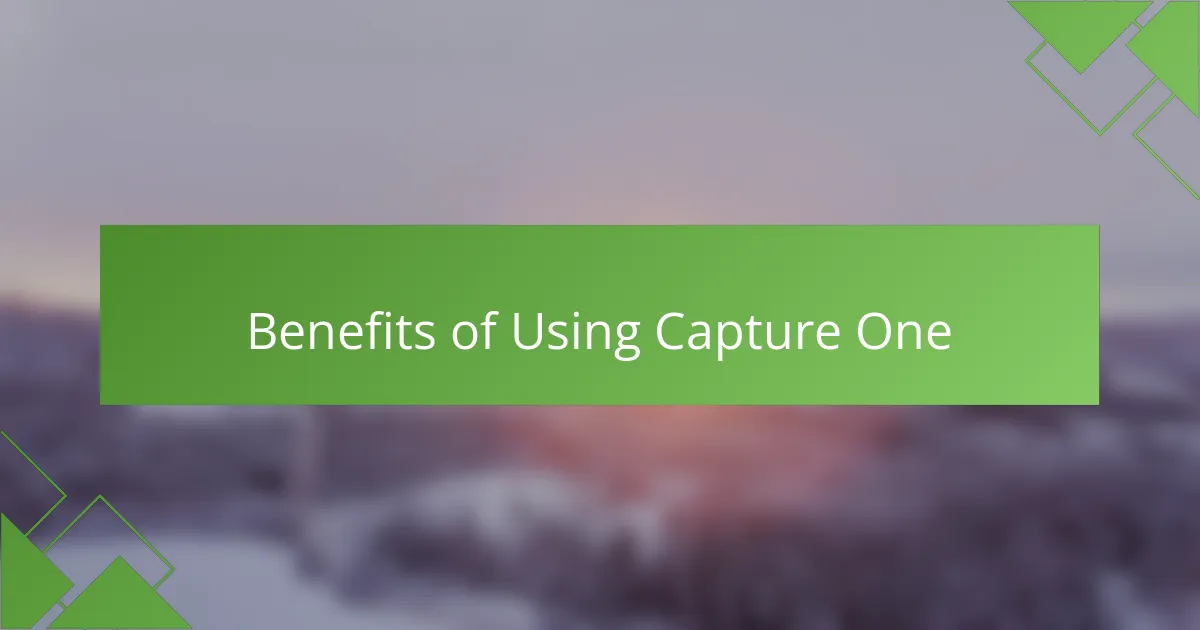
Benefits of Using Capture One
When I first started using Capture One for my editing process, I was immediately struck by its ability to handle RAW files. The software’s color grading tools made my images pop in ways I had never experienced before. I remember the excitement of enhancing a dull landscape shot into a vibrant scene that truly captured my vision.
Another advantage I found with Capture One is its customizable workspace, which allowed me to optimize my workflow. Organizing my tools to fit my unique editing style made the experience feel more intuitive. This flexibility helped me to focus more on my creative process rather than getting bogged down by the technical aspects.
- Exceptional color grading capabilities
- Advanced tethering options for studio photography
- Intuitive customizable workspace
- Powerful local adjustment tools
- Improved performance with large files
- Enhanced image management features
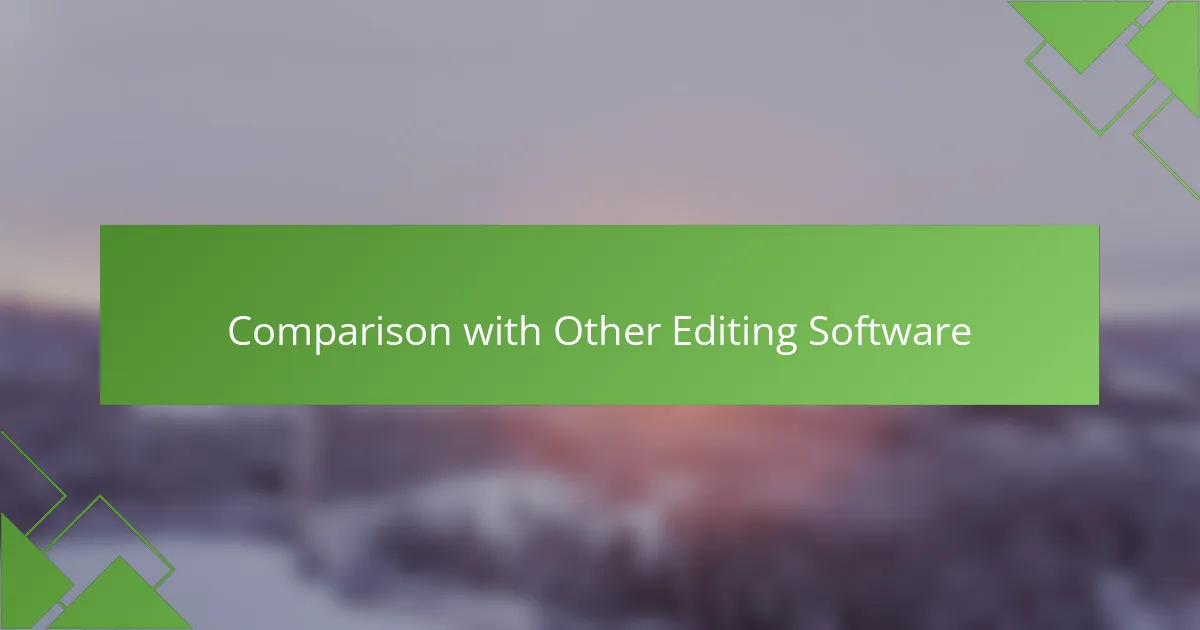
Comparison with Other Editing Software
When comparing Capture One to other editing software options, I often find that its color grading capabilities stand out distinctly. For instance, while Lightroom offers a solid foundation for color adjustments, I’ve felt that Capture One provides a more intuitive approach, allowing me to achieve precise control with ease. I remember the first time I used Capture One; the color wheel felt like an artist’s palette, and it genuinely enhanced my creativity.
Additionally, the file handling process in Capture One is noteworthy. I appreciate how it manages RAW files efficiently, which can sometimes be sluggish in other programs like Photoshop. This efficiency has saved me countless hours when editing large batches of photos during my projects. Here’s a quick comparison that highlights some key differences:
- Color Grading: Capture One’s advanced color editing tools often provide more nuanced results than Lightroom’s.
- Performance: Faster file handling in Capture One improves workflow significantly compared to Photoshop and other software.
- User Interface: The customizable workspace in Capture One feels more tailored to my editing style than in competitor programs.
- Tethering: Capture One excels in tethered shooting, offering a seamless connection to my camera that I’ve found lacking in alternatives.
- Cost: While Capture One can be more expensive upfront, I believe its features offer great value for serious photographers compared to subscription-based services.
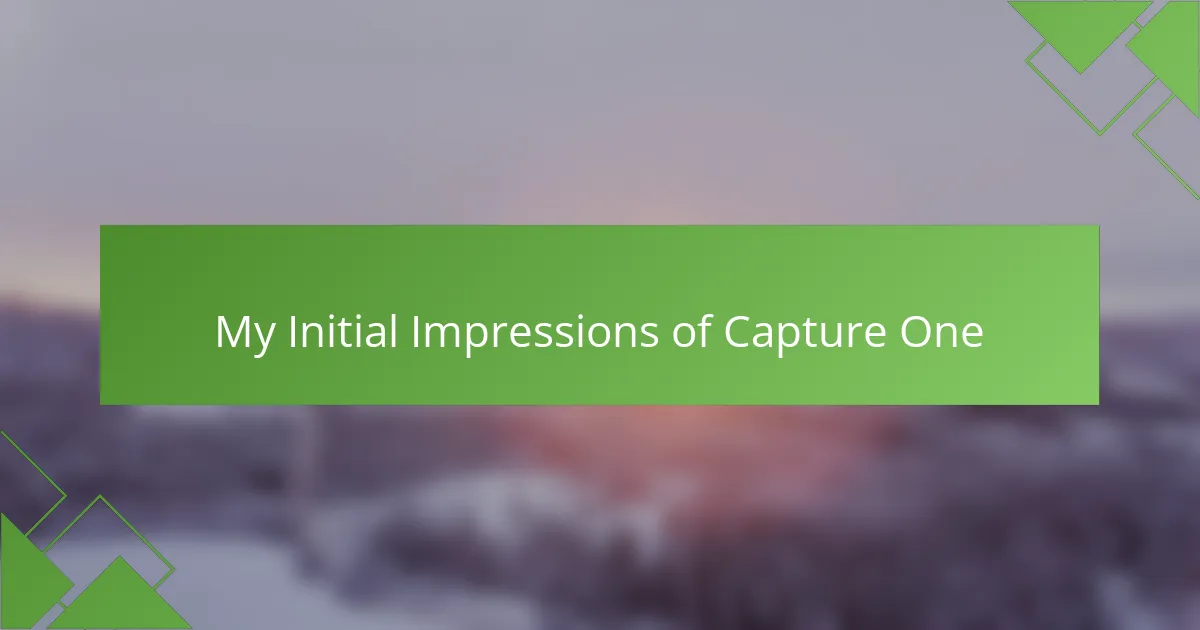
My Initial Impressions of Capture One
The first time I launched Capture One, I felt a surge of excitement mixed with a hint of anxiety. I was unsure how this new software would fit into my established workflow. However, as I explored the interface, I found it both modern and inviting, which eased my apprehension. The layout felt intuitive, almost as if it was designed with my needs in mind.
One of the most striking features that caught my attention was the color grading system. I vividly remember editing a portrait where I could manipulate the hues in real time. It was fascinating to see how a simple adjustment could transform the mood of the image entirely. I found myself wondering how I ever managed without such dynamic tools before.
Overall, my initial interaction with Capture One left me curious and eager to experiment. The blend of powerful features seemed to promise not just improvement in my editing skills but also a deeper connection to my images. I wondered, could this software be the key to unlocking new creative possibilities in my photography journey?
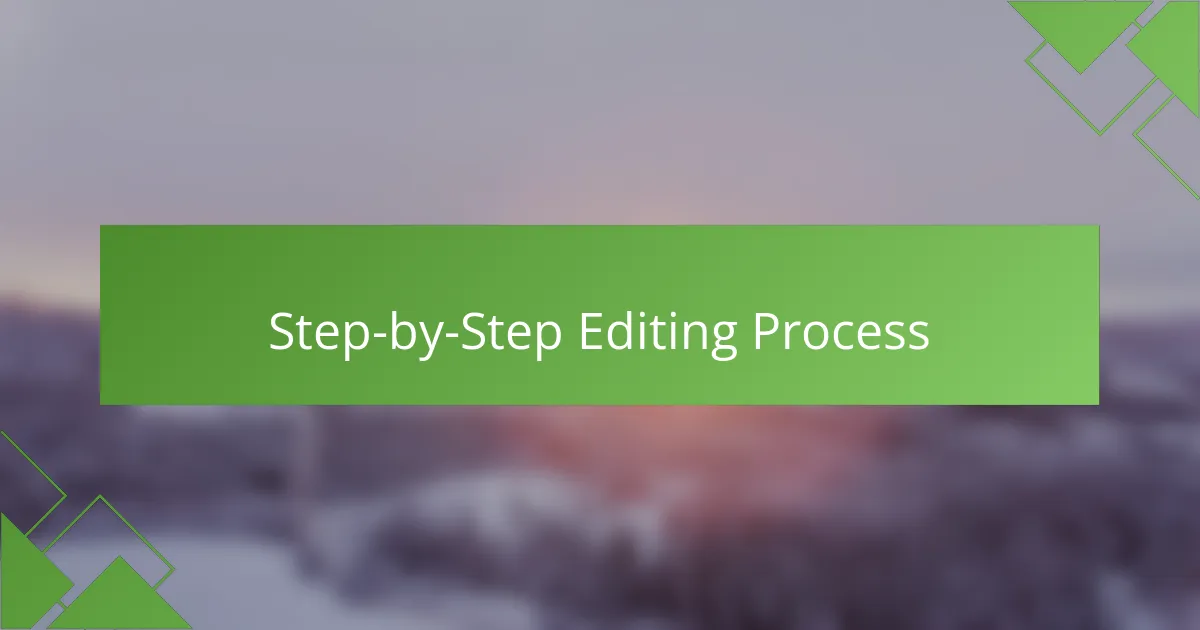
Step-by-Step Editing Process
When diving into my editing process with Capture One, I often begin with importing my images into the software. This creates an organized workspace where I can easily find and manage my photos. I recall my early days of editing; I felt overwhelmed, but now, the streamlined interface feels second nature and even enjoyable.
Next, I typically move on to adjusting the color balance and exposure. This is where Capture One really shines for me. I have vivid memories of experimenting with different looks, and I appreciate how the software allows me to make nuanced adjustments that enhance my original vision without losing detail. After this, I focus on refining my images through local adjustments. Using masks and gradients, I can draw attention to specific areas, and I love how satisfying it is to watch an image transform right before my eyes.
Here’s a quick comparison of my editing steps in Capture One versus my experience with other software:
| Step | Capture One |
|---|---|
| Importing Images | Organized workspace with ease of access |
| Color and Exposure Adjustments | Fine-tuning with precision tools |
| Local Adjustments | Satisfying transformation through masks and gradients |